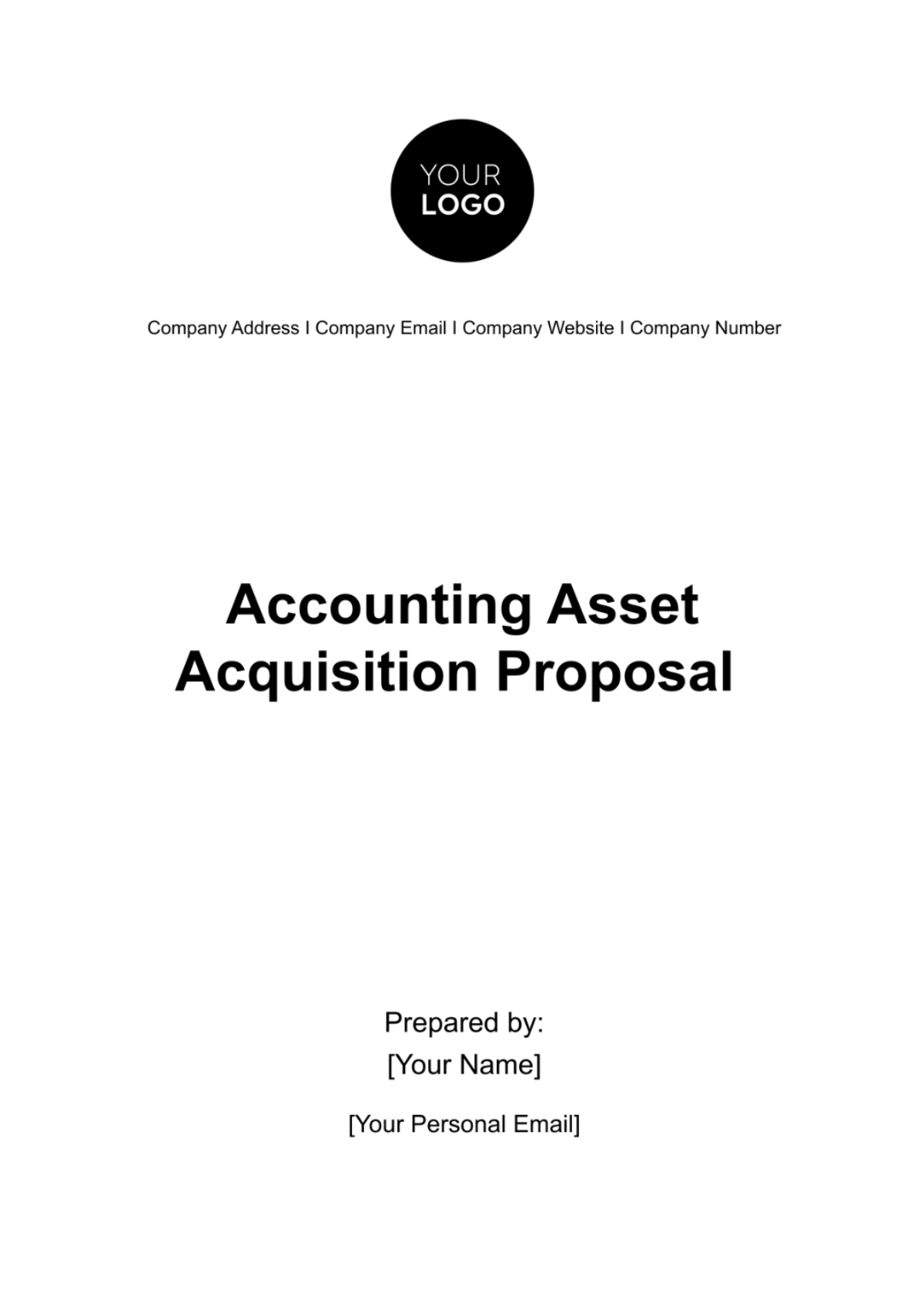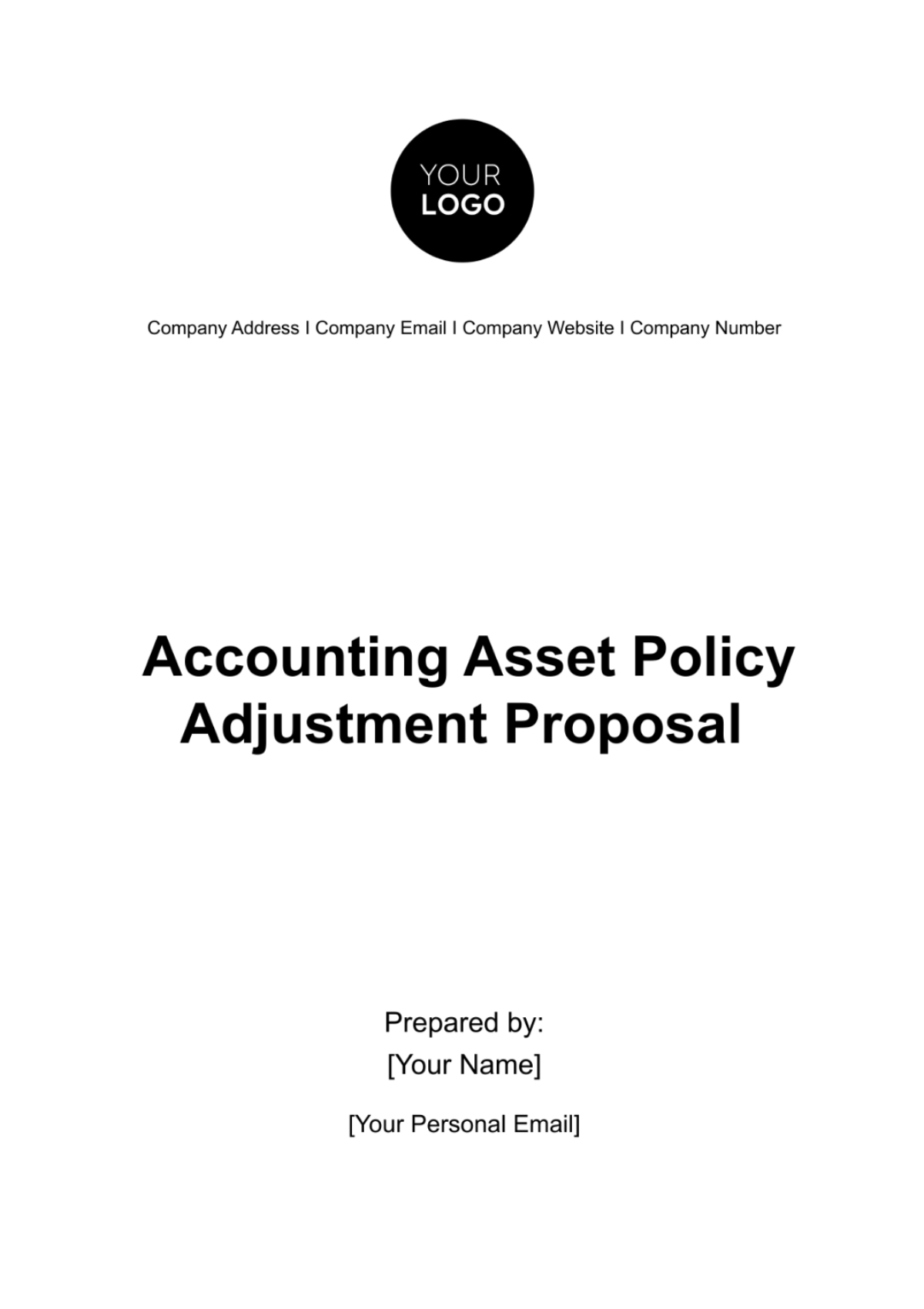Accounting Asset Policy Adjustment Proposal
I. Executive Summary
This proposal outlines necessary adjustments to the current accounting asset policies at [Your Company Name]. The motivation behind these adjustments is to enhance operational efficiency, ensure compliance with updated accounting standards, and better align our asset management practices with our strategic objectives. By refining our approach to asset valuation, depreciation, and reporting, we anticipate not only improved financial accuracy but also a stronger foundation for informed decision-making across the organization. The expected outcomes include streamlined processes, enhanced regulatory compliance, and optimized financial performance.
II. Introduction
The purpose of this proposal is to address and rectify identified shortcomings within our existing accounting asset policies. Given the evolving nature of business operations, regulatory environments, and accounting standards, it has become imperative to reassess and update our policies to maintain accuracy in financial reporting and asset management. This document provides a detailed analysis of the current policy framework, identifies areas for improvement, and presents a comprehensive plan for policy adjustment.
III. Current Policy Overview
The current asset management and accounting policies of [Your Company Name] were last revised in [Year], establishing a framework for asset classification, acquisition, valuation, depreciation, and disposal. These policies were designed to align with the financial reporting standards and operational needs at that time. However, recent shifts in regulatory standards, technological advancements, and our strategic direction have highlighted areas where our existing policies may no longer suffice.
Our current policies include:
Asset Classification: Assets are classified into fixed, intangible, and financial categories, with specific criteria for each classification.
Asset Acquisition: Procedures for asset acquisition emphasize purchase authorization and verification but lack guidance on evaluating leases versus purchases in light of the new IFRS 16 standards.
Asset Valuation: Valuation is based on historical cost, with limited provisions for adjustments reflecting market value or impairment.
Depreciation: Depreciation methods and schedules were determined based on industry norms and useful life estimates that may not accurately reflect current usage patterns or technological life cycles.
Asset Disposal: The disposal process focuses on physical asset disposal, with insufficient attention to the recapture of value for intangible assets or the strategic timing of asset sales.
Identified Limitations:
Regulatory Alignment: The introduction of new accounting standards, such as IFRS 16 on leases and updates to IAS 36 on impairment, has created gaps in compliance that need to be addressed.
Technological Adaptation: Rapid technological advancements have rendered some of our fixed assets obsolete faster than anticipated, challenging our existing depreciation schedules and valuation methods.
Strategic Fit: As [Your Company Name] has grown and diversified, the strategic role of certain assets has evolved, necessitating a review of how assets are managed to support our long-term objectives.
IV. Need for Adjustment
The imperative for adjusting our accounting asset policies emerges from a confluence of internal and external factors. Externally, the regulatory environment for financial reporting and asset management has evolved significantly. The adoption of IFRS 16, for example, requires a new approach to accounting for leases, transforming many previously classified operating leases into capital assets on the balance sheet. Similarly, advances in technology not only affect the valuation and depreciation of our assets but also introduce new risks and opportunities that our current policies do not adequately address.
Internally, our strategic review has identified that our asset portfolio's composition has shifted, with an increasing reliance on digital and intangible assets driving value creation for the company. This shift necessitates a more dynamic approach to asset management that can accommodate rapid changes in asset utility and value. Moreover, inconsistencies in asset management practices across different departments have been identified, leading to inefficiencies and potential inaccuracies in financial reporting.
Specific Areas for Adjustment:
Lease Accounting: Aligning our policies with IFRS 16 to accurately reflect lease obligations and rights as assets and liabilities.
Intangible Assets: Enhancing guidelines for the valuation, amortization, and impairment testing of intangible assets to better capture their contribution to our business.
Depreciation Methods: Revisiting depreciation methods and schedules to ensure they reflect the economic reality of asset usage and technological obsolescence.
Asset Disposal: Introducing a strategic approach to asset disposal that considers market timing and the potential for value recapture, especially for digital and intangible assets.
Given the strategic importance of these adjustments, a comprehensive review and update of our asset management policies are proposed.
V. Proposed Policy Adjustments
To address the identified needs for adjustment, we propose a series of specific changes to our accounting asset policies:
Lease Accounting Adjustment: Implementing a new policy to recognize right-of-use assets and lease liabilities on the balance sheet, including detailed guidelines on lease term determination, discount rate application, and expense recognition.
Intangible Assets Management: Introducing enhanced procedures for the initial recognition and ongoing valuation of intangible assets, including software, patents, and brand names. This will involve regular market value assessments and a more nuanced approach to amortization and impairment testing reflective of actual usage and market conditions.
Revised Depreciation Schedules: Updating our depreciation policies to incorporate a more granular classification of asset types, reflecting differences in technology lifecycle and usage patterns. This will include adopting more flexible depreciation methods, such as units of production for manufacturing equipment, to better match expense recognition with asset utilization.
Strategic Asset Disposal Framework: Establishing a comprehensive framework for the strategic disposal of assets, focusing on maximizing value recovery. This framework will include decision trees to guide the disposal or redeployment of assets based on their condition, market value, and strategic relevance to the company.
These proposed adjustments are designed to enhance the accuracy of our financial reporting, improve the efficiency of our asset management practices, and ensure compliance with current accounting standards. They reflect a commitment to maintaining the highest standards of financial integrity and operational excellence at [Your Company Name].
VI. Compliance and Regulatory Considerations
In proposing adjustments to our asset management policies, careful consideration has been given to compliance with both existing and emerging regulatory standards. The adjustments are specifically designed to address gaps identified in our compliance with the International Financial Reporting Standards (IFRS) and Generally Accepted Accounting Principles (GAAP), particularly concerning the latest updates in IFRS 16 (Leases) and IAS 36 (Impairment of Assets).
IFRS 16 Compliance: Our lease accounting adjustment ensures that all lease agreements are accounted for on the balance sheet, offering greater transparency and aligning with the IFRS 16 requirements. This adjustment necessitates a comprehensive review of all current leasing agreements and a reevaluation of our approach to future leases.
IAS 36 Compliance: The enhanced guidelines for the valuation and impairment testing of intangible assets are designed to ensure that the carrying amounts do not exceed their recoverable amounts, in line with IAS 36 standards. This will involve developing more rigorous internal processes for impairment testing, incorporating external market data, and predictive analytics.
VII. Impact Analysis
The proposed policy adjustments are expected to have a multifaceted impact on [Your Company Name]:
Financial Impact: Initially, there may be increased costs associated with implementing the new policies, such as investments in software or training programs. However, these costs are anticipated to be offset by improvements in the accuracy of our financial reporting and the optimization of our asset portfolio, leading to better-informed strategic decision-making and potentially significant cost savings in the long term.
Operational Impact: Adjusting our asset management policies will necessitate changes to our day-to-day operations. Departments will need to adapt to new procedures for asset acquisition, valuation, and disposal. While this may require an adjustment period, the long-term benefits include increased operational efficiency and better alignment of asset management practices with our strategic goals.
Strategic Impact: The proposed adjustments support [Your Company Name]'s strategic objectives by ensuring that our asset management practices are not only compliant with current standards but are also optimized to support growth and innovation. By enhancing the accuracy and efficiency of our asset management, we are better positioned to respond to market opportunities and challenges.
VIII. Implementation Plan
The implementation of the proposed policy adjustments will be overseen by a dedicated project team and will proceed according to the following timeline:
Phase | Activities | Timeline | Responsible Department |
|---|---|---|---|
1 | Policy Development & Review | [Number of Months] | Finance & Legal |
2 | Training & Software Implementation | [Number of Months] | HR & IT |
3 | Policy Rollout & Compliance Monitoring | [Number of Months] | All Departments |
4 | Review & Feedback Collection | [Number of Months] | Finance & Internal Audit |
IX. Risk Management
The implementation of new accounting asset policies inherently introduces several risks, including operational disruptions, resistance to change among staff, potential non-compliance issues, and unforeseen impacts on financial reporting. Recognizing these challenges, [Your Company Name] has developed a comprehensive risk management strategy to address and mitigate these risks effectively.
To tackle operational disruptions, we plan to implement the policy adjustments in phases, allowing each department to adapt to changes gradually and ensure business continuity. Detailed project plans, including timelines and milestones, will be shared with all departments in advance, and a dedicated support team will be established to address any operational issues that arise during the transition period.
Anticipating resistance to change is natural in any organization-wide initiative. To mitigate this, we will engage employees at all levels early in the process, incorporating their feedback into the policy development phase. Comprehensive training programs and clear communication about the benefits of the new policies will be crucial in fostering a positive attitude towards the changes. Champions within each department will be identified to advocate for the adjustments and assist their colleagues in the transition.
Potential non-compliance issues with both internal policies and external regulatory requirements present a significant risk. To address this, [Your Company Name] will conduct pre-implementation reviews with the legal and compliance teams to ensure all proposed policy adjustments are fully compliant. Post-implementation, regular compliance audits will be conducted, and findings will be reviewed to ensure any gaps are promptly addressed.
The unforeseen impacts on financial reporting due to policy adjustments are a concern that requires careful management. [Your Company Name] will employ scenario analysis and modeling to anticipate potential impacts on financial statements and performance metrics. This proactive approach will allow us to identify and mitigate negative impacts before the policy adjustments are fully implemented. Additionally, the finance team will work closely with auditors and external advisors to ensure that all changes are accurately reflected in financial reports and that stakeholders are well informed about the basis and implications of any significant changes.
X. Monitoring and Evaluation
To assess the effectiveness of the adjusted policies, [Your Company Name] will establish a set of metrics and KPIs related to asset management efficiency, compliance rates, and financial performance. Regular monitoring will be conducted by the finance department, with quarterly reviews to assess progress and identify areas for further improvement.
KPI Examples: Compliance rate with IFRS 16, average time for asset disposal, and ROI on new asset acquisitions.
Feedback Mechanism: Establishing channels for feedback from departments to continuously refine and improve the policies based on practical insights and experiences.
In addition to the initial set of metrics and KPIs outlined for evaluating the effectiveness of the adjusted policies, [Your Company Name] will implement a comprehensive audit mechanism to ensure thorough compliance and effectiveness checks. This audit will be conducted semi-annually by the internal audit department, with the first audit scheduled six months post-implementation. This structured evaluation process will focus on the practical application of the policies across all departments, identifying not just compliance levels but also the real-world impacts on operational efficiency, asset utilization, and financial reporting accuracy. Feedback gathered during these audits, combined with regular performance data analysis, will serve as critical inputs for continuous policy refinement. By establishing a cycle of ongoing evaluation and adjustment, we ensure that our asset management practices remain agile, responsive to changes in the business environment, and aligned with our strategic objectives.
XI. Conclusion
The proposed adjustments to [Your Company Name]'s accounting asset policies represent a proactive and strategic approach to enhancing our asset management practices. By aligning our policies with current regulatory standards and optimizing them for operational efficiency and strategic growth, we position our company for sustained success.
The journey to refining [Your Company Name]'s accounting asset policies through the proposed adjustments is a strategic initiative aimed at bolstering our company’s asset management framework to meet contemporary challenges and capitalize on future opportunities. As we conclude this proposal, it’s evident that the adjustments are not merely a response to regulatory changes but a proactive measure to enhance operational efficiency, financial integrity, and strategic agility. The successful implementation of these policy adjustments will require the collective effort and commitment of the entire organization, from executive leadership to individual contributors. With a structured approach to implementation, rigorous monitoring and evaluation, and a commitment to continuous improvement, we are poised to achieve a new standard of excellence in asset management. This proposal, therefore, is not just a blueprint for policy adjustment but a roadmap towards a more dynamic, efficient, and strategically aligned asset management practice that will drive [Your Company Name] towards achieving its long-term goals and sustaining its competitive edge in the marketplace.
XII. Appendices
Appendix A: Detailed Comparison of Current vs. Proposed Policies
Appendix B: IFRS 16 and IAS 36 Compliance Checklists
Appendix C: Training Program Outline for New Asset Management Policies













